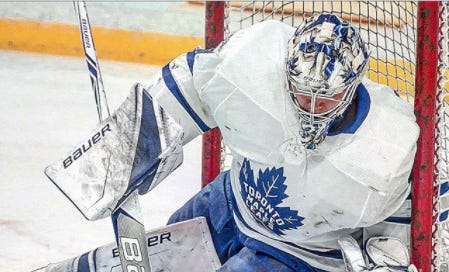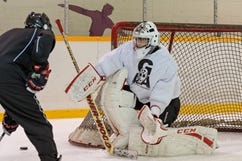The History of Hockey Goalie's Post Play
Evolution of how goalies have played against “dead angle” shots
Welcome to the first installment of Goalie’s Arsenal, where our goalie contributor Josh Howell will examine the tactics and strategies used by the most important position in the greatest game on earth. It’s great for goalie nerds and the shooters trying to find ways to solve the goalie.
Today we’re going to discuss the techniques and strategies goalies have used over the years to defend against the “dead angle” shot.
What is a dead angle shot?
A “dead angle shot” is a shot from anywhere below the faceoff circles.
Goaltending is a game of angles and coverage. The net is 6-feet wide and 4-feet tall, but from the shooter’s perspective, this is only true when the puck is in the center of the offensive zone.
As the puck moves further to the outside of the zone, the space available for the puck to enter the net shrinks considerably. When the puck gets below the bottom of the faceoff circles, the net is effectively 15-inches wide. Because the goalie can easily cover the entire opening of the goal from this angle, these chances are considered “dead”.
Goals from this area of the ice are almost always considered bad goals. The below graphic illustrates the actual space available to a shooter from a bad angle.
Dead Angle Techniques Through the Years
The Bubble Hockey Goalie (1980s)
In the 1980’s, the preferred method for shutting down dead angle chances was to stay on your feet with both leg pads closed tightly, sealing against the post with the outside pad and torso in order to establish 100% net coverage. In today’s nomenclature, we might refer to this as the V-V (vertical-vertical) as both pads are situated vertically against the post.
This method left goalies with little to no leverage on plays in tight and severely limited mobility on rebounds and pass outs.
The Overlap (1990s)
In the 1990’s, the proliferation of the butterfly saw goalies change their approach to dead angle plays.
The overlap (OL) involves a typical butterfly save selection with the post-side skate overlapping the post. This technique allows a goaltender to establish 100% net coverage while being disengaged from the post.
The OL offers better leverage on in tight chances, with both pads sealing the ice. However, with the goalie being positioned slightly outside the frame of the net, it creates more space behind the goalie to fill for a rebound, wraparound, or pass out.
Vertical-Horizontal (2000s)
in the 2000’s, the vertical-horizontal (V-H) emerged as the preferred technique on dead angle plays. The V-H gets its name from the orientation of the goalie’s pads, with the post-side pad situated against the post vertically and the inside pad sealing the ice horizontally.
This method enables goalies to establish complete coverage on dead angle chances while allowing for a more natural, powerful push off the post with the vertical leg directly below the goalie’s hips and shoulder. With the inside pad placed vertically along the ice, rebound control is often an issue, with shots off of the inside pad being directed into the high-danger slot area.
Reverse Vertical-Horizontal (2010s)
The reverse V-H (RVH) is the most widely used post-play technique in the modern game. The RVH involves placing the post-side pad horizontally along the ice, with the skate blade against the post, while the inside pad remains vertical, using the inside skate blade to anchor oneself in position.
This provides leverage against wraparounds and in tight plays. One distinctive advantage of the RVH is the ability to keep rebounds off the horizontal pad on the strong side of the ice, putting the goaltender in a better position to make a second save. As seen in the pictures below, the RVH can often leave the short side corner uncovered. When goals are scored short side it’s often called a “RVH Fail”
As the game continues to evolve, goalies evolve with it. One day in the not so distant future, a new technique will become the norm, and we’ll look back at the RVH with the same skepticism as we do the Bubble Hockey goalie in 2021.
Read More: A Painfree Deep Dive Into The RVH
Did you enjoy this newsletter?
Help us grow this community and share it! A referral is always the best compliment.











